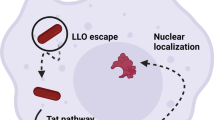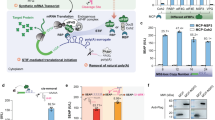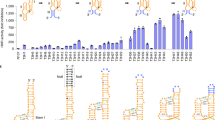Abstract
Heterologous mammalian gene regulation systems for adjustable expression of multiple transgenes are necessary for advanced human gene therapy and tissue engineering, and for sophisticated in vivo gene-function analyses, drug discovery, and biopharmaceutical manufacturing. The antibiotic-dependent interaction between the repressor (E) and operator (ETR) derived from an Escherichia coli erythromycin-resistance regulon was used to design repressible (EOFF) and inducible (EON) mammalian gene regulation systems (E.REX) responsive to clinically licensed macrolide antibiotics (erythromycin, clarithromycin, and roxithromycin). The EOFF system consists of a chimeric erythromycin-dependent transactivator (ET), constructed by fusing the prokaryotic repressor E to a eukaryotic transactivation domain that binds and activates transcription from ETR-containing synthetic eukaryotic promoters (PETR). Addition of macrolide antibiotic results in repression of transgene expression. The EON system is based on E binding to artificial ETR-derived operators cloned adjacent to constitutive promoters, resulting in repression of transgene expression. In the presence of macrolides, gene expression is induced. Control of transgene expression in primary cells, cell lines, and microencapsulated human cells transplanted into mice was demonstrated using the E.REX (EOFF and EON) systems. The macrolide-responsive E.REX technology was functionally compatible with the streptogramin (PIP)–regulated and tetracycline (TET)–regulated expression systems, and therefore may be combined for multiregulated multigene therapeutic interventions in mammalian cells and tissues.
This is a preview of subscription content, access via your institution
Access options
Subscribe to this journal
Receive 12 print issues and online access
$209.00 per year
only $17.42 per issue
Buy this article
- Purchase on Springer Link
- Instant access to full article PDF
Prices may be subject to local taxes which are calculated during checkout





Similar content being viewed by others

References
Fussenegger, M. The impact of mammalian gene regulation concepts on functional genomic research, metabolic engineering, and advanced gene therapies. Biotechnol. Prog. 17, 1–51 (2001).
Chin, L. et al. Essential role for oncogenic Ras in tumour maintenance. Nature 400, 468–472 (1999).
Malleret, G. et al. Inducible and reversible enhancement of learning, memory, and long-term potentiation by genetic inhibition of calcineurin. Cell 104, 675–686 (2001).
Niwa, H., Miyazaki, J. & Smith, A.G. Quantitative expression of Oct-3/4 defines differentiation, dedifferentiation or self-renewal of ES cells. Nat. Genet. 24, 372–376 (2000).
Ewald, D. et al. Time-sensitive reversal of hyperplasia in transgenic mice expressing SV40 T antigen. Science 273, 1384–1386 (1996).
Aubel, D. et al. Design of a novel mammalian screening system for the detection of bioavailable, non-cytotoxic streptogramin antibiotics. J. Antibiot. 54, 44–55 (2001).
Rivera, V.M. et al. A humanized system for pharmacologic control of gene expression. Nat. Med. 2, 1028–1032 (1997).
Bohl, D., Naffakh, N. & Heard, J.M. Long-term control of erythropoietin secretion by doxycycline in mice transplanted with engineered primary myoblasts. Nat. Med. 3, 299–305 (1997).
Serguera, C., Bohl, D., Rolland, E., Prevost, P. & Heard, J.M. Control of erythropoietin secretion by doxycycline or mifepristone in mice bearing polymer-encapsulated engineered cells. Hum. Gene Ther. 19, 375–383 (1999).
Wang, Y., O'Malley Jr., B.W., Tsai, S. & O'Malley, B. A regulatory system for use in gene transfer. Proc. Natl. Acad. Sci. USA 91, 8180–8184 (1994).
Ye, X. et al. Regulation of therapeutic proteins after in vivo somatic cell gene transfer. Science 283, 88–91 (1999).
Fussenegger, M., Bailey, J.E. & Varner, J. A mathematical model of caspase function in apoptosis. Nat. Biotechnol. 18, 768–774 (2000).
Fussenegger, M., Schlatter, S., Dätwyler, D., Mazur, X. & Bailey, J.E. Controlled proliferation by multigene metabolic engineering enhances the productivity of Chinese hamster ovary cells. Nat. Biotechnol. 16, 468–472 (1998).
Fux, C. et al. Streptogramin- and tetracycline-responsive dual regulated expression of p27Kip1 sense and antisense enables positive and negative growth control of Chinese hamster ovary cells. Nucleic Acids Res. 29, E19 (2001).
Moutsatos, I.K. et al. Exogenously regulated stem cell-mediated gene therapy for bone regeneration. Mol. Ther. 3, 449–461 (2001).
Rossi, F.M.V. et al. Tetracycline-regulated factors with distinct dimerization domains allow reversible growth inhibition by p16. Nat. Genet. 20, 389–393 (1998).
Umaña, P., Jean-Mairet, J., Moudry, R., Amstutz, H. & Bailey, J.E. Engineered glycoforms of an antineuroblastoma IgG1 with optimized antibody-dependent cellular cytotoxic activity. Nat. Biotechnol. 17, 176–180 (1999).
Gossen, M. & Bujard, H. Tight control of gene expression in mammalian cells by tetracycline-responsive promoters. Proc. Natl. Acad. Sci. USA 89, 5547–5551 (1992).
Gossen, M. et al. Transcriptional activation by tetracyclines in mammalian cells. Science 268, 1766–1769 (1995).
Fussenegger, M. et al. Streptogramin-based gene regulation systems for mammalian cells. Nat. Biotechnol. 18, 1203–1208 (2000).
Boorsma, M. et al. A novel temperature inducible replicon-based DNA expression system. Nat. Biotechnol. 18, 429–432 (2000).
Moser, S. et al. Dual-regulated expression technology: a new era in adjusting heterologous gene expression in mammalian cells. J. Gen. Med. 3, 529–549 (2001).
Guay, D.R.P. Macrolide antibiotics in paediatric infection diseases. Drugs 51, 515–536 (1996).
Williams, J.D. & Sefton, A.M. Comparison of macrolide antibiotics. J. Antimicrob. Chemother. (suppl. C) 31, 11–26 (1993).
Noguchi, N. et al. Nucleotide sequence and characterization of erythromycin resistance determinant that encodes macrolide 2'-phosphotransferase I in Escherichia coli. Antimicrob. Agents Chemother. 39, 2359–2363 (1995).
Noguchi, N., Takada, K., Katayama, J., Emura, A. & Sasatsu, M. Regulation of transcription of the mph(A) gene for macrolide 2'phosphotransferase I in Escherichia coli: characterization of the regulatory gene mphR(A). J. Bacteriol. 182, 5052–5058 (2000).
Triezenberg, S.J., Kingsbury, R.C. & McKnight, S.L. Functional dissection of VP16, the transactivator of herpes simplex virus immediate early gene expression. Genes Dev. 2, 718–729 (1988).
Fussenegger, M., Mazur, X. & Bailey, J.E. A novel cytostatic process enhances the productivity of Chinese hamster ovary cells. Biotechnol. Bioeng. 55, 927–939 (1997).
Rodvold, K.A. Clinical pharmacokinetics of clarithromycin. Clin. Pharmacokinet. 37, 385–398 (1999).
Fussenegger, M., Moser, S., Mazur, X. & Bailey, J.E. Autoregulated multicistronic expression vectors provide one-step cloning of regulated product gene expression in mammalian cells. Biotechnol. Prog. 13, 733–740 (1997).
Moosmann, P., Georgiev, O., Thiesen, H.J., Hagmann, M. & Schaffner, W. Silencing of RNA polymerases II and III-dependent transcription by the KRAB protein domain of Kox1, a kruppel-type zinc finger factor. Biol. Chem. 387, 669–677 (1997).
Moser, S. et al. An update of pTRIDENT multicistronic expression vectors: pTRIDENTs containing novel streptogramin-responsive promoters. Biotechnol. Prog. 16, 724–735 (2000).
Cheung, W., Minton, N. & Gunawardena, K. Pharmacokinetics and pharmacodynamics of epoietin alfa once weekly and three times weekly. Eur. J. Clin. Pharmacol. 57, 411–418 (2001).
Aiello, L., Guilfoyle, R., Huebner, K. & Weinmann, R. Adenovirus 5 DNA sequences present and RNA sequences transcribed in transformed human embryo kidney cells (HEK-Ad-5 or 293). Virology 94, 460–469 (1979).
Schlatter, S., Rimann, M., Kelm, J. & Fussenegger, M. SAMY, a novel mammalian reporter gene derived from Bacillus stearothermophilus α-amylase. Gene 282, 19–31 (2002).
Bristow, A. A collaborative study for the establishment of a biological reference preparation for erythropoietin. Pharmeuropa 2, 31–48 (1997).
Acknowledgements
We thank N. Noguchi for providing pTZ3509, A. Weber for bibliographic work, E. Niederer (ETH Institute of Biomedical Engineering) for FACS, and J. Zanghi for critical comments on the manuscript. This work was supported by Cistronics Cell Technology (Zurich, Switzerland) and the Swiss National Science Foundation (grant 631-065946). This paper is dedicated to James E. Bailey, an outstanding scientist, friend, and mentor who passed away during the final revision of this manuscript.
Author information
Authors and Affiliations
Corresponding author
Ethics declarations
Competing interests
The authors declare no competing financial interests.
Supplementary information
Rights and permissions
About this article
Cite this article
Weber, W., Fux, C., Daoud-El Baba, M. et al. Macrolide-based transgene control in mammalian cells and mice. Nat Biotechnol 20, 901–907 (2002). https://doi.org/10.1038/nbt731
Received:
Accepted:
Published:
Issue Date:
DOI: https://doi.org/10.1038/nbt731
This article is cited by
-
An orthogonalized PYR1-based CID module with reprogrammable ligand-binding specificity
Nature Chemical Biology (2024)
-
A gene signal amplifier platform for monitoring the unfolded protein response
Nature Chemical Biology (2020)
-
Gene networks that compensate for crosstalk with crosstalk
Nature Communications (2019)
-
Synthetic biology of cell signaling
Natural Computing (2016)
-
Comparative study between macrolide regulatory proteins MphR(A) and MphR(E) in ligand identification and DNA binding based on the rapid in vitro detection system
Analytical and Bioanalytical Chemistry (2016)


